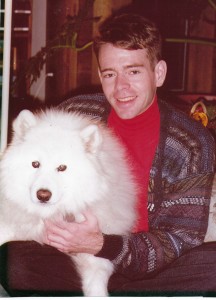 Early morning on the Summer Solstice, twenty years ago, my 31-year old son, Kenneth died of AIDS. This fact has insured that I would never forget the anniversary of his crossing and always be reminded of the gift of his life.
Early morning on the Summer Solstice, twenty years ago, my 31-year old son, Kenneth died of AIDS. This fact has insured that I would never forget the anniversary of his crossing and always be reminded of the gift of his life.
There was heartbreaking loss and blessed relief in those final hours. When the path to recovery and a longer life is no longer possible, death becomes the desired goal – the end to pain and suffering for our loved ones and for ourselves. And then begins the long journey of grief and bereavement as we continue on without them. I didn’t know then that my loss would eventually become a resource for my life, a spark of sweet sorrow where remembering would be a way to continue my love for Ken and to give his life meaning in the larger world.
- Do you have stories of lessons learned from someone no longer with you?
- Have you found special ways to honor a loved one now deceased?
- What reminds you of your deceased loved one and how do you respond when that occurs?
- Are you aware of ways you can extend your loved one’s legacy beyond their lifetime?
Ken’s 3½-year journey living with the disease had meant managing the fear and pain of a death-defying challenge and the social stigma and resulting isolation necessary at that time to live life as fully as possible. “Do not tell anyone,” he was told by the AIDS Outreach Center, “even your best friend, if you want to keep your job.”
 Experimenting with medication trials and ways to manage their side effects, Ken bravely continued to life the life he wanted for himself. He called on skills learned in his theater career to help him put aide the discomforts and difficulties and step into his life’s stage in the role of a healthy person. His doctor called his strategy “healthy denial.” It was not a denial of the fact of having a serious disease, but of its inevitable outcome. Ken repeated often to himself, “My main focus is to take really good care of myself so I’ll be here when the cure arrives.”
Experimenting with medication trials and ways to manage their side effects, Ken bravely continued to life the life he wanted for himself. He called on skills learned in his theater career to help him put aide the discomforts and difficulties and step into his life’s stage in the role of a healthy person. His doctor called his strategy “healthy denial.” It was not a denial of the fact of having a serious disease, but of its inevitable outcome. Ken repeated often to himself, “My main focus is to take really good care of myself so I’ll be here when the cure arrives.”
The cure is still not here. In spite of the great strides made for AIDS to become a chronic disease people can live with – people must know they have the disease and must have access to the newer medications. More than 1.1 million people in the U.S. are living with HIV today, and 1 in 7 of them don’t know it. An estimated 37,600 Americans became newly infected in 2014.
Some years I celebrate Ken’s anniversary by finding ways to call attention to and educate young people about the facts of HIV/AIDS. One year, my improv troupe Wing & a Prayer Pittsburgh Players used the singing, dancing, storytelling improv art-based system of InterPlay to introduce teens to Ken’s story in the program Educating Teens About HIV/AIDS.
http://www.educatingteens.org/mission.html
I knew what Ken would say to them if he had the opportunity and using his voice I got their attention. I figure, preventing even one person a year from getting AIDS is a great way to remember Ken. It feels good to know that something I’ve done on behalf of Ken’s memory may have contributed to the fact that, in the U.S, there are fewer new cases. From 2005 to 2014, the estimated number of annual HIV infections in the U.S. declined 18%.

